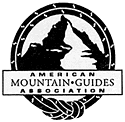
A Day on Mount Everest
Climbers Examine the Deadly Climb of May 10, 1996 In Memory of Scott Fischer
A Day on Mount Everest
Climbers Examine the Deadly Climb of May 10, 1996 In Memory of Scott Fischer

Neal Beidleman, Guide |
The highlight of the day-long event was a slide presentation by Neal Beidleman, a member of Fischer's 1996 Everest expedition who took over the leadership role when Fischer was separated from his group in a sudden storm on May 11 and later died near the summit. Beidleman's presentation included not just his own images, but the last frames of film exposed by Fischer before his death and later taken from his camera. Scott Fischer's final photographs show that he was on his way down from the summit in deteriorating conditions as the storm approached. The photographs, however, shed no light on the tragedy that followed, except to suggest that Fischer's mental faculties were apparently not significantly impaired by cerebral edema when the shots were taken.
Biedleman's low-key but emotional presentation was enthusiastically received by the more than 400 climbers in attendance. The slide show followed a spirited discussion by six American Everest veterans who addressed controversial issues relating to climbing the highest peaks on earth, such as the increase in guided ascents on Mount Everest. Symposium members included Anatoli Boukreev and Charlotte Fox, who were members of Scott Fischer's expedition, and Jim Williams, who was on Mount Everest with the Alpine Ascents International Expedition when the fatal storm struck. The dean (and chief comedian) of panel was Tom Hornbein, a member of the expedition that made the first American ascent of Mount Everest in 1963.
Proceeds from "A Day on Mount Everest" went to benefit Scott Fischer's two children, and to establish both an expedition fund and an educational fund in Fischer's name. The special event's primary sponsor was Outside Magazine, and also included contributions from Climbing Magazine, Patagonia, Nike and others.
Contributions to the fund can be sent to:
Fischer-Price Children's Fund
Seafirst Bank, W. Seattle Branch
4001 SW Alaska St.
Seattle, WA 98116
(206) 358-2230
-- Peter Potterfield, Mountain Zone Staff
Members of Scott Fischer's Everest expedition share their thoughts:
Anatoli Boukreev; first person to guide Everest from both the north and south sides and has summited eleven of the world's fourteen 8,000 meter peaks.
"Climbing an 8,000-meter peak is among the most dangerous challenges a person can ever undertake. No matter how experienced a climber is, the thrill of the summit must be weighed against the very real risks."
Boukreev gives his account of the events of the May summit bid and his role in guiding clients through the storm.
Charlotte Fox; the first American woman to climb three 8,000 meter peaks
"Our expedition was experienced and strong. Because of that, Scott, Neal and Anatoli gave us a lot of freedom that subsequently has been criticized. But that freedom and independence went a long way toward getting us back alive in the storm."
"That night of the storm, I was very proud of the members of our team. They did a great job and by working together we were able to get back to camp safely while others did not. I think we were strong and tenacious, but we were also damn lucky. On another day the outcome might have been completely different."
Neal describes Summit Day, May 11, 1996: lead sherpa Lopsang Jangbu's altitude sickness, confusion over setting ropes, nervousness over the delay, and the experience of standing on top of Mount Everest.